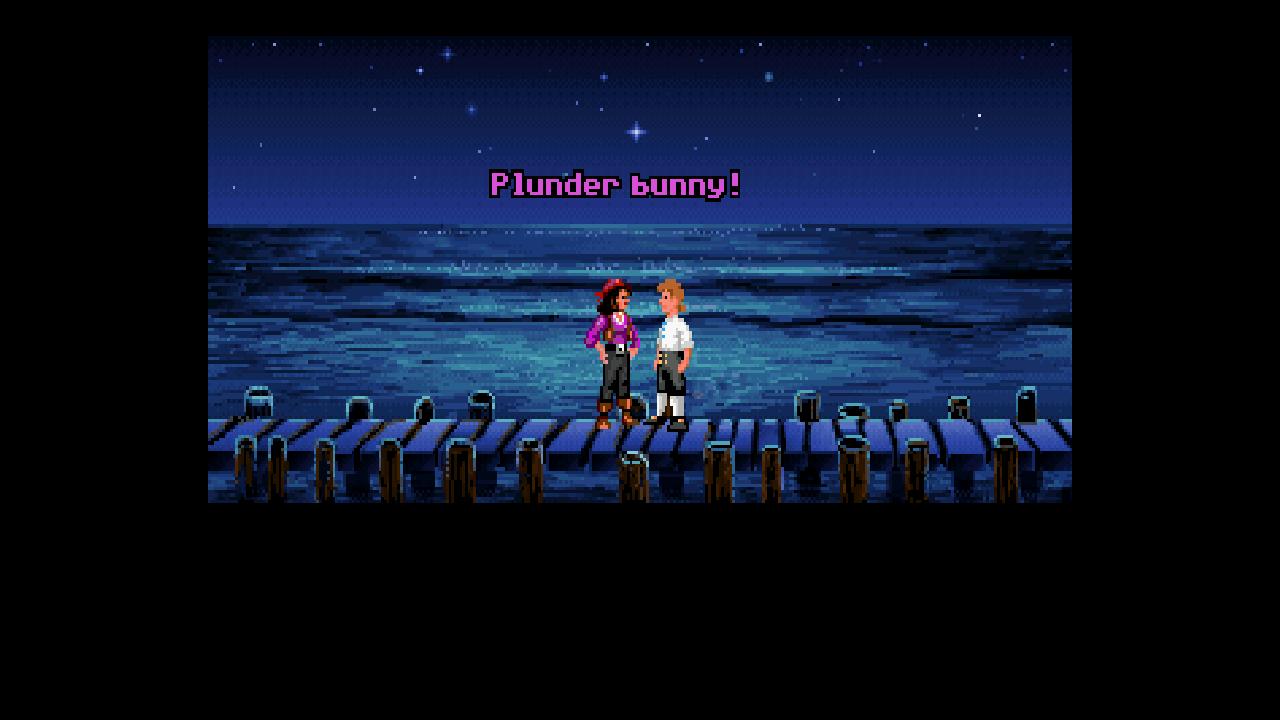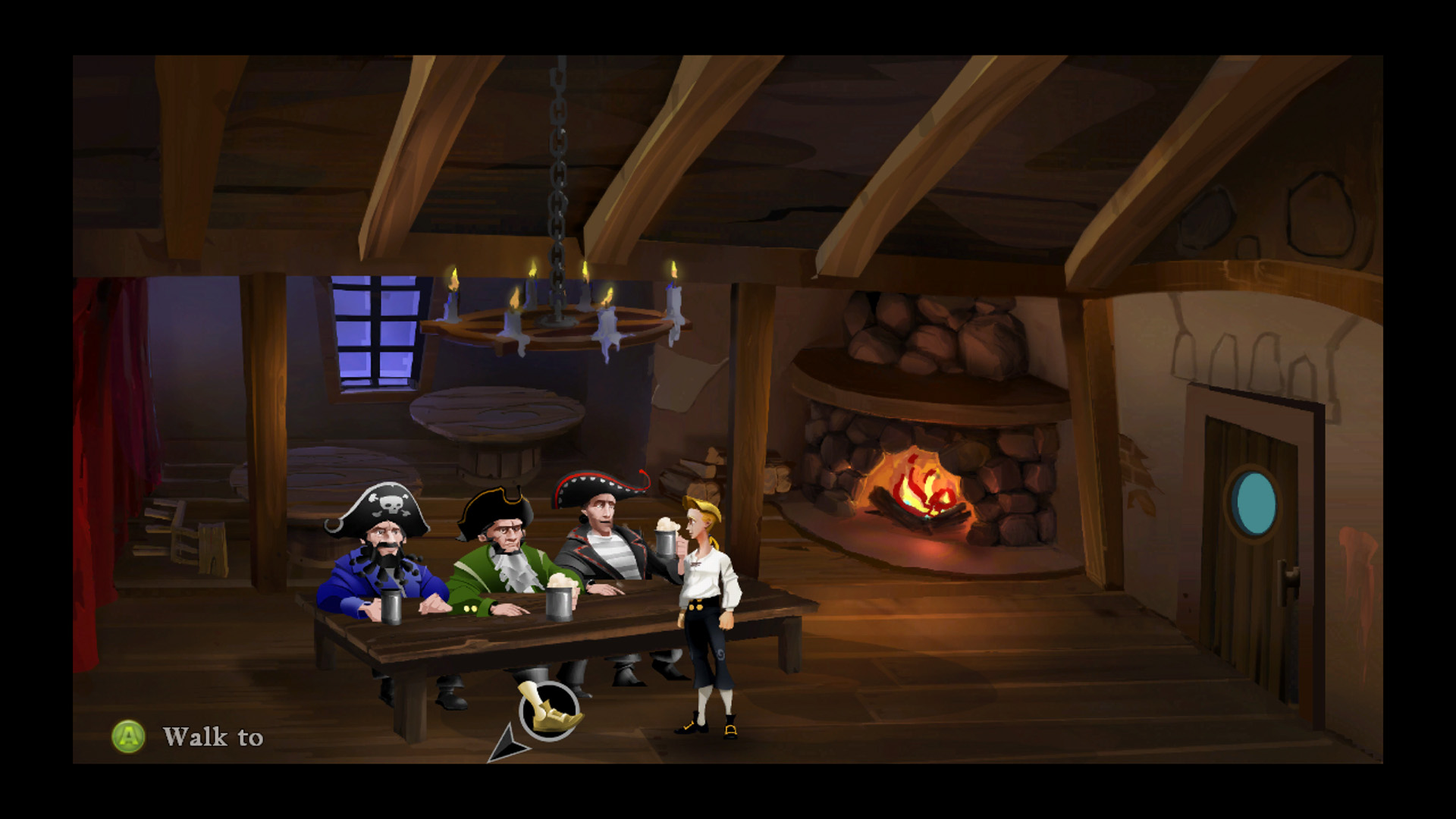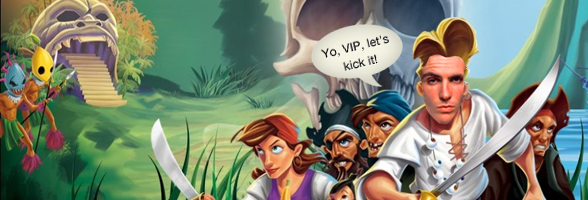Note that this opinion of the Special Edition is of its merits as an update to the classic game it includes, a game which is indisputably a five skull masterpiece.

Monkey Island’s one-two punch comeback last July caught all of us off guard. After years of neglecting their old franchises with such commitment that you couldn’t help but admire the sheer unassailability of their track record of apathy, LucasArts abruptly unveiled a remake of The Secret of Monkey Island alongside Telltale’s episodic fifth installment of the series, Tales of Monkey Island, in a move that epitomized a substantial and rather refreshing shift in direction for the company. On top of both projects being quality efforts, they are significant on another level for what they represent on LEC’s part – the welcoming embrace of a fanbase that spent the better part of a decade left out in the cold.
Although just about all the adventure builders from the old days are long gone – in many cases, to places like Telltale and Double Fine - it turns out there are a nonetheless a number of folks still employed at LucasArts who, like us, harbor a deep-seated love for the classic adventure IPs. The small team assembled to craft this remake (the same group who went on to make Lucidity and will allegedly be concocting future original titles) were clearly bound by a limited budget and constrained schedule for this experiment to be justifiable, but an enthusiasm shines through in the final result, and it’s clear when playing the special edition that everyone involved in the project took pride in ensuring that their mark on the Monkey Island legacy wouldn’t be a blemish.

One decision that speaks to this level of reverence is the fact that the remake is built directly on top of the code of the SCUMM powered original (the VGA CD-ROM version from 1992, to be exact). This allows for the game’s greatest feature, which is the ability to toggle between the enhanced and “classic” versions of the game at any time by hitting F5. In addition to the tremendous value of having a built-in copy of the original game in its entirety, it’s a total blast to switch back and forth and compare the versions in order to appreciate/scrutinize the team’s translation at an obsessive level of detail, making at least one playthrough a worthwhile experience even for those of us who know the original game better than we should. That this toggle feature is even possible means, of course, that the core game remains virtually identical, with all the changes to tailor Monkey Island to new audiences being purely presentational. And that’s the way it should be.
Visually, the game looks great, although calling it an improvement doesn’t feel accurate. Sporting an appealing, stylized look (some have likened it to a painted picture book) that is both distinct and a reasonable fit for the franchise as a whole, the results are generally admirable although somewhat mixed, especially at the details level. I want to be clear: the rich, high resolution backgrounds, adhering slavishly to the VGA art as reference material, are a pleasure to look at the whole way through, but some awkward choices here and there (the font used on any given sign is an eyesore) and the occasionally messy residue of rush work (see if you can spot the leftover pixels from what wasn’t painted over) make the revamped scenery a worthy effort, but not one which can be called definitive.
This unevenness extends to the character designs and animation, the latter limited to the same number of frames as the twenty year old game being drawn over despite using far crisper sprites. As a result, the game loses a degree of the grit and even, ironically, some of the detail of its pixel-laden foundation. Still, this all feels really nitpicky to write about, and all in all the art team has to be commended for a job well done. Heck, they even restored the close-up of Spiffy the dog in the SCUMM Bar – that pretty resolutely answers the question of whether or not the people involved knew what they were doing. It is not the only nod aimed at the direction of hardcore fans, either.
Where the game’s look might be a mixed bag, the audio is pure excellence. The completely remastered soundtrack, a painstaking labor of love headed by in-house composer Jesse Harlin, is sensational. The new tracks, complemented by some effective ambience work in the sound design department, include some use of live instruments and do great justice to Michael Land’s iconic score. The voice acting, directed by Darragh O‘Farrell (reprising the position he served on CMI and EMI) is also thoroughly top notch. Although there is an inevitable degree of flatness that comes out of voicing a game whose dialog was written to be read, and I’m not sure I agree with the existence of a vocalized narrator (played by Denny Delk of Murray the demonic skull fame), none of those quirks are the fault of acting or direction, but are borne from the concept. Recognizing that limitation, it’s fantastic to have the option to hear Armato, Boen and Boyd voice dialogue we’ve been pretending they had in our heads since The Curse of Monkey Island came out, making for a pleasing continuity. Incidentally, the majority of the minor characters that ended up getting voiced in subsequent games (whether that happened first with the third or fourth installment) return to their roles here as well, including some, like the Voodoo Lady and Stan, that Telltale ended up recasting for Tales.

The interface gets a bit of a keeloverhaul in this remake as well, though it’s mostly to accommodate the Xbox gamepad. The inventory and verbs are no longer a static part of the screen, and are instead pulled up by respective key/button presses to allow the actual game world to take up the entire display. Despite that benefit, the effect this redress has on the gameplay is decidedly a detriment; it is now rather clumsy to construct your sentences when interacting (especially in the case of item combination) where it was previously a quicker and more intuitive experience. You’ll find yourself particular stressed, for example, when solving the puzzle of escaping Otis from jail. On a brighter note, the game also includes the feature of a well designed, built-in hint system in the vein of the company’s old hint books to prevent today’s gamers from pulling their hair out, a risk that’s always present in the face of the quaint and acquired taste that is the logic of a traditional graphic adventure.
When it’s all said and done, while I don’t consider The Secret of Monkey Island: Special Edition to be the ideal version of the game, I’m forced to admit that my judgment probably has more to do with nostalgia than it does with the objective quality of the effort. What is the preferred version of Monkey Island, after all, but the version that each of us grew up with? Whereas the hardcore like us will pick apart this remake for all the little ways it “wronged” the original, decrying how modern gamers are being exposed to the franchise improperly, I can’t help but be reminded of similarly charged comparisons that have been made between, say, the EGA version of the game versus the VGA version. Whenever I see someone griping about Guybrush’s facial expression or hair style in this remake, I think of similar complaints I’ve witnessed or been part of in IRC chatrooms about things like the VGA version’s removal of the Melee Island sunset. There is still a school of thought that the CD-ROM version is a form desecration for its removal of the “Disk 22” stump joke (and even its reference in the credits!). There are those who only want to hear the MIDIs/bleeps coming out of their speakers, who prefer the flying chest as opposed to the flying boulder when Guybrush breaks the dam, who insist that the incongruously realistic 256-color close-ups are an unacceptable replacement for the Purcell originals.

For its part, The Secret of Monkey Island: Special Edition is, or should be, a welcome treat for longtime fans for being another version (and not a replacement, as some offended diehards bizarrely seem to take it as) of the game for us to add to the line-up and enjoy for its strength and weaknesses, just like all the others. Indeed, it’s hard to feel anything but gratitude about its existence for that reason alone, and moreover for successfully rejuvenating a classic franchise, exposing a whole new generation of gamers to Guybrush’s engrossing and hilarious adventures. Whatever the opinion of the Mojo community when it comes to the geekier points, it’s clear that the spirit of game fully survived the face lift, and that LEC’s mission was a successful one. With the recently announced special edition of LeChuck’s Revenge coming our way, the company is aiming for that success to be duplicated. Judging from what’s been shown so far, it’s going to make this one look like a test run.
Review by Jason
The Secret of Monkey Island: Special Edition is available on Steam for $9.99.
